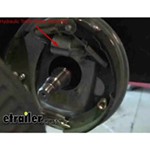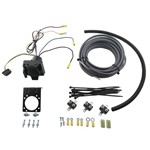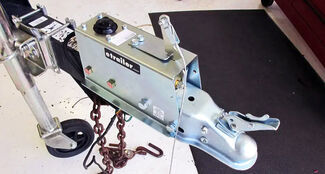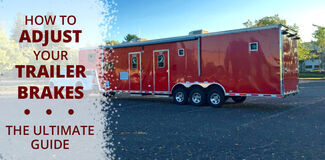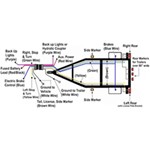
How to Replace the Axle on your Boat Trailer
Step Zero: Prep work
Floor jack and a minimum of four jack stands A set of wheel chocks Sockets and wrenches matching the bolts on your trailer suspension Breaker bar (technically optional, but you won't catch me replacing a marine axle without one) Mallet (to remove rusted-on Shackle bolts) Impact wrench (this is also technically optional, but will make the process much easier)
The new axle (if that wasn't obvious) A hub assembly if your new axle doesn't already have one Note: For questions regarding your hub assembly, check out our article on replacing your hub assembly here Leaf springs (if you are replacing them as well) Hardware (we recommend using new hardware to secure your new axles) Shackle bolts (if you're replacing your leaf springs as well) U-bolt kit Lug nuts (as needed)
Step One: Jack up your Trailer

Step Two: Remove your Wheels
If you do need an extra bit of "persuasion" to get your lug nuts off, then it may be time to replace them. Click here to grab a new set!

Step Three: Detach your Brake Components (If you have them)
Many smaller boat trailers will not have brakes, but it's important to check. If you do have brakes on your boat trailer, make sure to disconnect your brake lines and remove your brake assemblies.
Step Four: Remove your U-bolts
After your u-bolts are disconnected, slide your axle out from under your trailer. Next, remove the shackle bolts connecting your leaf springs to the trailer (some leaf springs have only one shackle bolt, these are called slipper springs, but they function similarly otherwise). The shackle bolts will likely be somewhat difficult to remove because they are designed to "dig into" the metal of the trailer, but with a mallet you should be able to knock them free. Once they are removed, you can set your old leaf springs aside and attach the new ones. For more information on what that process looks like in detail, click here to read our guide on leaf spring replacement!

Step Five: Replace your Axle

Step Six: Secure your new axle
Note: If the plate you're connecting your u-bolts to has a "lip" on the outer edges, make sure that it is facing down. This promotes water runoff and can keeps your hardware in good shape for as long as possible.
If your new axle does not have an installed hub assembly, or if you are re-using your hub from your previous axle, now is the time to install that. For a detailed explanation of that process, click here to read our guide on hub replacement.

Step Seven: Reattach your brake components (if applicable)
If your trailer has hydraulic brakes you need to bleed the brake lines as well to keep air from getting in. For a step-by-step guide to bleeding your brake lines check out our guide here.
Step Eight: Finishing up
Once your wheels are on and the lug nuts tightened by hand, you can put your jack back under the frame of your trailer and start removing it from the trailer jacks. It's very important to be careful during this part, as not to damage your boat, your trailer, or your jack stands (you'll need them again now that you can fix your own boat trailer, right?)


Departments
Towing
- Trailer Hitch
- Fifth Wheel
- Gooseneck
- Towing a Vehicle
- Front Hitch
- RV Hitch
- ATV Hitch
- HD Truck Hitch
- Vehicle Wiring
- Brake Controller
- Ball Mounts
- Weight Distribution
Sports and Recreation
Trailer Parts
- Utility Trailer
- Boat Trailer
- Landscape Trailer
- Enclosed Trailer
- 5th/Camper Trailer
- Car Hauler
- Horse Trailer
Vehicle
Contact & Help

What our customers are saying:
"Very helpful/friendly Customer Service. Competitive Pricing. Shipping was Fast."
John
Mankato, MN

















